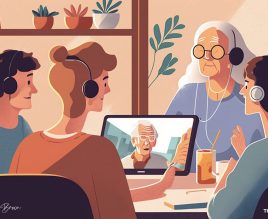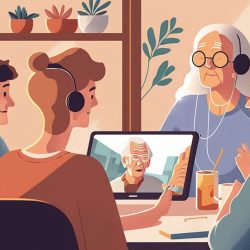Table of Contents
ToggleIn the exciting crossroads where innovative technology meets the noble mission of elder care, a promising tool emerges – ChatGPT (Generative Pre-training Transformer). A state-of-the-art AI language model, ChatGPT’s capabilities reach beyond just answering questions and setting reminders.
It has the potential to transform senior living, paving the way for a new approach to elder care. Imagine an environment where seniors don’t just survive, but thrive – engaging, learning, and interacting with an AI companion that caters to their individual needs.
ChatGPT’s ability to understand and generate human-like text allows for limitless, dynamic interactions. Its potential application in senior living is as vast as it is exciting, serving a unique role in providing information, companionship, and even mental stimulation.
By implementing ChatGPT in senior living settings, we might not just improve quality of care, but also enrich seniors’ lives. This fusion of cutting-edge AI with senior care offers a distinctive perspective on the role technology can play in addressing the needs of an aging population. Now, the question isn’t just about the feasibility of this concept, but rather how we can make it a reality.
Combining the human touch with AI’s consistency and scalability, ChatGPT could bridge the gap in senior care. From combating loneliness to assisting with daily tasks and offering cognitive therapy, the potential benefits are worth exploring.
In this article, we’ll dive into the prospect of implementing ChatGPT solutions in senior living, discussing its potential benefits, real-world applications, and the exciting “what if” scenarios that could redefine our understanding of elder care.
Understanding ChatGPT
As technology continues to revolutionize our lives, it’s essential to keep up with the latest advancements, especially when they offer significant potential benefits for senior living. One such technology is ChatGPT, a conversational AI model that could reshape how we approach elder care. Let’s delve deeper into what ChatGPT is, how it functions, and the unique potential it holds within senior care settings.

Introduction to ChatGPT and its Functionality
ChatGPT, an AI model developed by OpenAI, stands at the forefront of natural language processing technology. It’s designed to understand context, generate human-like text, and engage users in dynamic, fluid conversations. Functioning as a chatbot, it reads input from a user, interprets the context, and produces a relevant response.
But ChatGPT is not a simple chatbot. It’s trained on a vast dataset, encompassing a diverse range of internet text. This diverse training equips ChatGPT to generate informative, nuanced, and engaging responses, setting it apart from more basic chatbots. It can answer questions, write essays, summarize texts, and even compose poetry, making it a versatile tool for various applications, including senior care.
In essence, ChatGPT leverages the power of machine learning to provide a conversational experience that can be educational, engaging, and therapeutic. Its adaptability and potential for personalized interaction make it an exciting prospect for innovative solutions in elder care.
The Power of AI in Senior Care
The advent of AI in senior care heralds a new era of potential solutions for some of the most persistent challenges in the sector. Chatbots, in particular, are proving to be more than just digital assistants; they are becoming companions, mental health aids, and personalized sources of information and entertainment.
Implementing AI chatbots like ChatGPT in senior living contexts could address several crucial issues. Loneliness, for instance, is a significant problem in senior living facilities, and regular interaction with an AI chatbot can provide a sense of companionship and regular interaction.
Moreover, AI can assist with routine tasks, provide reminders for medication, and even offer cognitive exercises to help keep seniors’ minds active. The sophistication and versatility of AI chatbots, coupled with their availability round the clock, could significantly enhance the quality of care provided in senior living facilities.
In essence, integrating AI like ChatGPT into senior care can provide consistent, personalized support, supplementing the human touch with technology’s scalability and precision. This fusion of human care and AI could potentially redefine the senior living experience.
The Benefits of Implementing ChatGPT in Senior Living
The union of AI technology and senior living could revolutionize elder care. ChatGPT, as a dynamic AI chatbot, carries a multitude of potential benefits for seniors, their families, and care teams. Let’s delve into the key advantages of implementing ChatGPT in senior living contexts, focusing on enhanced communication and empowering seniors.
Enhancing Communication

One of the foremost benefits of implementing ChatGPT in senior living facilities is the enhancement of communication. As a chatbot, ChatGPT is designed to foster conversation, facilitating a seamless and engaging two-way communication channel. For seniors, this can provide a companionable presence, offering regular interaction and alleviating feelings of isolation or loneliness that can accompany old age.
ChatGPT’s capabilities extend beyond companionship. It can be programmed to provide regular updates and reminders, enhancing the clarity and consistency of communication with seniors. This could include reminders for medications, meal times, or scheduled activities, ensuring seniors stay informed and on track.
Communication is fundamental in senior care, and ChatGPT could be instrumental in bridging gaps. For seniors, engaging with ChatGPT can provide a platform for expression and interaction, combating feelings of loneliness and isolation often associated with old age.
Family members, often juggling their personal responsibilities and their loved ones’ care, could also benefit. They could interact with ChatGPT to stay informed about their loved ones’ activities, mental state, or reminders, fostering a sense of connection and involvement.
For the care team, ChatGPT could provide insights into seniors’ cognitive health, emotional state, and overall well-being, informed by their interactions with the AI. By aiding in monitoring and tracking seniors’ mental health, ChatGPT could help caregivers provide more personalized and effective care.
In essence, implementing ChatGPT in senior living could lead to a more interconnected ecosystem of care, enhancing communication between seniors, their families, and caregivers.
Empowering Seniors and Enhancing Independence
Another significant benefit of ChatGPT is its ability to empower seniors and enhance their independence. As we age, the ability to maintain autonomy and self-sufficiency becomes increasingly important for our mental health and overall sense of wellbeing.
ChatGPT can assist in maintaining this independence by offering help with routine tasks. This might include setting reminders, answering questions, or providing educational and entertaining content on demand. It can also offer cognitive stimulation through activities such as trivia games, story-telling, or discussions on a variety of topics.
Importantly, ChatGPT is available around the clock, meaning that seniors can seek help or engage in conversation whenever they choose, not just during designated activity hours or when human caregivers are available. This can increase their sense of independence and control over their daily life.
Moreover, ChatGPT could provide cognitive exercises that can stimulate mental activity, helping seniors keep their minds sharp and engaged. The AI’s availability around the clock offers a level of independence to seniors, allowing them to engage in conversations or request assistance when they need it, even during non-peak hours or when human caregivers are occupied.
By offering these features, ChatGPT could foster a sense of empowerment among seniors, enhancing their independence, and ultimately, improving their quality of life in senior living facilities.
Implementing ChatGPT in Senior Living: Practical Steps
Embracing the potential of ChatGPT in senior living involves a thoughtful approach to implementation. As with any new technology, successful deployment hinges on understanding unique needs, setting clear objectives, and a well-executed implementation plan. In this section, we’ll walk through the practical steps involved in bringing ChatGPT into senior living contexts, from assessing needs to monitoring the system’s effectiveness.

Assessing Needs and Setting Objectives
A key initial step in implementing ChatGPT in senior living settings is to assess needs and set clear objectives. This process begins by understanding the unique needs of your specific community.
Start by determining the residents’ needs. Are they seeking increased social interaction? Do they require assistance with day-to-day tasks or reminders? Are they in need of cognitive stimulation or companionship? Each senior living community is unique, so understanding the specific needs of your residents is crucial in tailoring the ChatGPT solution to meet these needs.
Consider also the needs of your caregiving team. ChatGPT can help in streamlining tasks, organizing communication, and monitoring residents’ wellbeing, so understanding the challenges faced by your caregivers will be instrumental in maximizing the benefits of the ChatGPT implementation.
Once you have a clear understanding of the needs within your community, you can set targeted objectives for your ChatGPT implementation. These objectives will guide your strategy and provide a clear measure of success. They could range from reducing loneliness among residents, improving communication within the care team, or helping seniors to maintain their independence.
It’s important to be specific with your objectives, as they will form the foundation of your implementation plan. By having clear, defined objectives, you can monitor the effectiveness of the ChatGPT solution and make necessary adjustments, ensuring it brings the maximum benefit to your community.
Remember that implementing ChatGPT is a dynamic process, and it’s normal for needs and objectives to evolve over time. Regular reassessments will ensure that your ChatGPT solution continues to meet the needs of your residents and caregivers, and helps to enhance the quality of life within your senior living community.
Implementing and Monitoring ChatGPT
Once needs are assessed and objectives set, it’s time to implement ChatGPT. This process starts with setting up the system, which should be user-friendly, intuitive, and accessible for both residents and staff.
Next, staff should receive thorough training to effectively utilize ChatGPT and assist residents. This training should cover basics, such as how to interact with ChatGPT, as well as troubleshooting common issues.
Upon launching, it’s important to closely monitor the system to assess effectiveness and identify any hiccups. Regular checks on user satisfaction, system functionality, and goal attainment can help ensure that ChatGPT meets the set objectives.
Feedback from residents and staff will be valuable in refining the implementation, ensuring that ChatGPT serves its purpose effectively and enhances the quality of life in the senior living setting. This iterative process can lead to a successful fusion of AI and senior care, revolutionizing how we approach elder care.
Case Studies: Successful Implementations of ChatGPT in Senior Living
To illustrate the potential of implementing ChatGPT in senior living, let’s consider two real-world scenarios that showcase successful applications of this technology. Sunshine Senior Living, a medium-sized elder care facility in California, identified a growing need for social interaction among its residents. To address this, they decided to implement ChatGPT as a tool for engagement and companionship.
After conducting thorough staff training and setting up user-friendly devices for residents, they launched ChatGPT. The result was transformative. Residents began engaging in meaningful conversations with the AI, ranging from sharing personal stories to discussing current events. A resident named Mary, who often felt lonely, found comfort in ChatGPT, which was programmed to provide reminders of her cherished memories.
Not only did this alleviate her loneliness, but it also helped her cognitive functioning by recalling these memories. ChatGPT’s successful implementation at Sunshine Senior Living demonstrates how AI can foster companionship and mental stimulation, significantly improving residents’ quality of life.
Oak Tree Elder Care, a large senior living facility in Texas, faced challenges in managing residents’ daily reminders and ensuring effective communication between residents and their families. They decided to implement ChatGPT to tackle these issues.
Following the assessment of their needs and setting clear objectives, Oak Tree integrated ChatGPT into their system. The AI was tasked with providing residents with reminders for medication, meals, and activities, effectively aiding in the management of daily routines.
Furthermore, ChatGPT served as a communication bridge between residents and their families. Residents’ family members could interact with the AI to stay informed about their loved ones’ activities, fostering a deeper connection. The results were promising. Caregivers reported decreased workload stress, and families appreciated the regular updates. Residents, on the other hand, found the reminders helpful and appreciated the feeling of increased independence.
Conclusion
Embracing technology in elder care opens up possibilities for innovative solutions to longstanding challenges. As we’ve explored, implementing ChatGPT in senior living holds immense potential. From enhancing communication between seniors, their families, and the care team, to empowering seniors by enhancing their independence, ChatGPT stands as a promising tool for improving the quality of life in senior living facilities.
Case studies have shown that the integration of ChatGPT can bring tangible benefits. However, it’s crucial to approach implementation with a clear understanding of the unique needs and objectives of each facility, alongside a well-planned strategy for setup, training, and monitoring.
As we venture further into the era of AI, senior living facilities have the opportunity to leverage tools like ChatGPT, not just to meet their residents’ basic needs, but to enhance their overall experience, enrich their lives, and redefine the landscape of elder care.
FAQ
What are the potential benefits of implementing ChatGPT in senior living?
Implementing ChatGPT in senior living has several potential benefits. These include enhancing communication, combating loneliness, and fostering independence among seniors. ChatGPT can serve as a companion, offering engaging conversations and emotional support.
Its capabilities can be leveraged to assist seniors with routine tasks and reminders, thereby promoting self-sufficiency. Furthermore, ChatGPT can provide cognitive stimulation, which can contribute to maintaining cognitive health. Lastly, it can act as a bridge, improving communication among seniors, their families, and the care team.
What are some practical steps for implementing ChatGPT in my senior living facility?
Firstly, assess the specific needs of your facility, considering both the residents and the care team. Following this, set clear objectives for what you aim to achieve with ChatGPT.
Implementation begins with setting up a user-friendly system and providing comprehensive training for the staff. After launching, monitor the system closely, gathering feedback from users and making necessary adjustments. This iterative process ensures that ChatGPT is effectively utilized and brings maximum benefits to your facility.
Can ChatGPT replace human caregivers in a senior living facility?
ChatGPT is an incredible tool with numerous potential applications in senior care, but it’s not designed to replace human caregivers. Rather, it’s intended to supplement human care.
ChatGPT can handle routine tasks, provide mental stimulation, and serve as a companion, but it lacks the human touch, emotional understanding, and physical abilities of a human caregiver. Consider it a valuable addition to the caregiver team, enhancing the care provided without replacing the irreplaceable human element.
How secure is ChatGPT? Can we trust it with seniors’ data?
ChatGPT is designed with privacy and security in mind. However, as with any technology that handles personal data, it’s crucial to have robust data privacy and security measures in place.
Regular audits, data encryption, and strict privacy policies should be implemented to ensure seniors’ data remains secure. In the end, it’s about finding the balance between leveraging the benefits of ChatGPT and ensuring the privacy and security of seniors’ information.
References
- https://www.frontiersin.org/
- https://www.apa.org/
- https://www.cam.ac.uk/

















